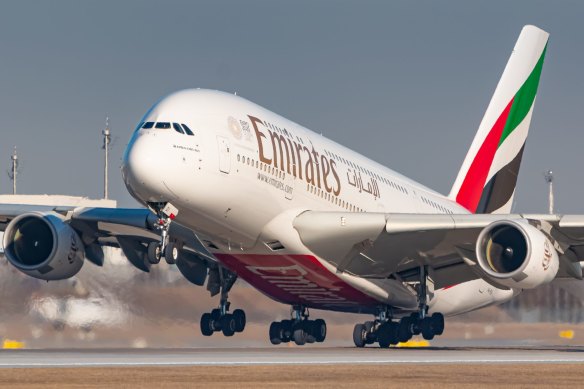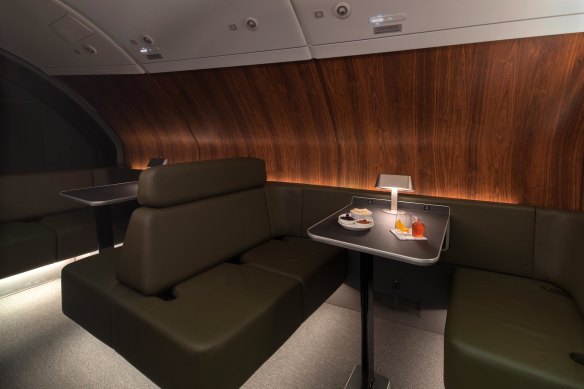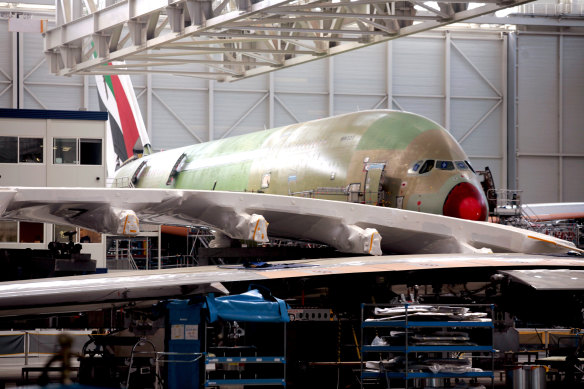Big is back: The superjumbo’s post-pandemic resurgence
By John Arlidge
Airbus is hinting it might resume production of the ‘king of the skies’ – the prospect of a new version is a tantalising possibility.
Christian Scherer, the head of Airbus’s civil aircraft division, sparked excitement last month when he suggested that the European plane-maker might resume production of its four-engine A380 double-decker superjumbo. Airbus scrapped production of the $US665 million “king of the skies” in 2021 after airlines opted for smaller, more fuel-efficient twin-engine jets. But Scherer told the German newspaper Hamburger Abendblatt that while the door to the A380 production line “is closed, it is not locked. In industry, nothing is ever ruled out.”

Emirates is the largest operator of Airbus A380 superjumbos.Credit: iStock
The reason for his teasing announcement? The A380 is enjoying a remarkable comeback. When COVID struck, many airlines decided to scrap “the big bird” because, with fuel costs rising and predictions that demand for business- and first-class travel would crater post-pandemic, most figured the behemoth would be unprofitable. Premium seats may only account for one quarter of the double-decker but they generate three-quarters of its operating profit.
But Lufthansa, Qatar Airways, Korean Air, Japan’s ANA and Etihad, the Abu Dhabi flag carrier, have all done a U-turn at 39,000 feet and re-introduced the A380 (only Air France and Malaysian Airlines have stuck to their original decision).
What’s more, those airlines which remained committed to the A380 all along have improved it. Singapore Airlines has refurbished its superjumbos, even introducing double beds in Suites Class at the front of the upper deck. Qantas’s A380s now boast top designer David Caon’s business-class suite and a bar at the front of the upper deck. British Airways’ chief executive, Sean Doyle, recently announced that his airline’s 12 A380s will be refitted with the new Club Suite on the upper deck and a new First Class, also likely on the upper deck, rather than downstairs as it is now.

Qantas’ updated business class lounge on board its A380s.
A new kid on the airport block, Global Airlines, recently secured its first A380, which it flew from the US to Prestwick in Scotland for a refit. Global’s founder, James Asquith, wants to use a fleet of A380s to “transport passengers back to the golden age of air travel”, starting with flights from London to Los Angeles and New York. The former investment banker is refurbishing the first of the four superjumbos he and his investors have bought to create a large bar on board. First-class ticket holders will be chauffeur-driven to the airport for Global flights. Food and drink will be “the best at 39,000 feet” and include Laurent-Perrier champagne, even for economy-class passengers, he promises.
Overall, 145 Airbus A380s are back in the air, spread across 10 airlines, according to aviation analysts ch-aviation.
The A380 is back thanks to the double whammy of rising demand and constrained fleets. A new aircraft that many airlines had hoped would replace it, the Boeing 777X, the world’s largest and most efficient twin-engine jet, is years behind schedule. It should have been in the air by now but has been delayed by a combination of post-COVID supply-chain snarl-ups and Boeing senior managers’ desperate efforts to rescue the firm’s troubled 737 Max, which has distracted from new jet development.
Predictions of a post-COVID slump in air travel, especially in business and first class, proved wildly wrong. In 2022, global air passenger demand grew by 64 per cent, compared with the previous year. It is forecast to grow by another 9.8 per cent by the end of this year. The only way airlines can satisfy rising demand and fill the Boeing 777X-sized gap in their fleets is to revive a jet that is many passengers’ favourite because it offers more space in all classes than single-decker jets.

An A380 during its assembly at Airbus’ factory in Toulouse, France, in 2008.Credit: Getty Images
The most popular revived A380 routes are to airports whose expansion is constrained – Dubai to London, London to Los Angeles, Dubai to Sydney, London to Singapore. With no new airport slots available at Heathrow and few at Sydney, it makes sense to use larger aircraft to boost passenger numbers. An A380 can accommodate almost 600 passengers in a three-class configuration.
Scherer’s comments are music to the ears of Sir Tim Clark, the boss of Emirates, who has long argued for an A380 mk II, with a longer fuselage creating 120 more seats and more fuel-efficient engines to reduce the per seat operating cost. Emirates is the biggest operator of the A380 with 118 in service of the 123 it bought.
While Emirates waits to see if a new A380 might tear down the runway, it is spending $2 billion refurbishing its existing fleet. At a sprawling hangar near Dubai International Airport, at least two A380s are being gutted and retrofitted every month.
On the lower deck, 56 new premium economy seats are being installed in the forward section. Behind premium economy, 338 refurbished economy seats now have a pitch (measure of legroom) of up to 34 inches, the most generous in the sky.
Upstairs, the 76 new business-class suites have quilted cream leather seats and lighter wood veneer. The overhead bins on each side are being removed to create a greater sense of space. The bar has a larger sofa on one side and a table for four on the other. The walls of the 14 first-class suites are higher and the seat wider and better upholstered. Motifs of the ghaf tree, a symbol of the United Arab Emirates, decorate walls across the jet, including in the showers.
A few of the carrier’s oldest A380s have been stripped down and will be used to provide spare parts for the current fleet to keep it in the air as long as possible – until maybe, just maybe, a bigger and better model rolls out of Airbus’s Toulouse factory.
The Telegraph, London
Sign up for the Traveller newsletter
The latest travel news, tips and inspiration delivered to your inbox. Sign up now.